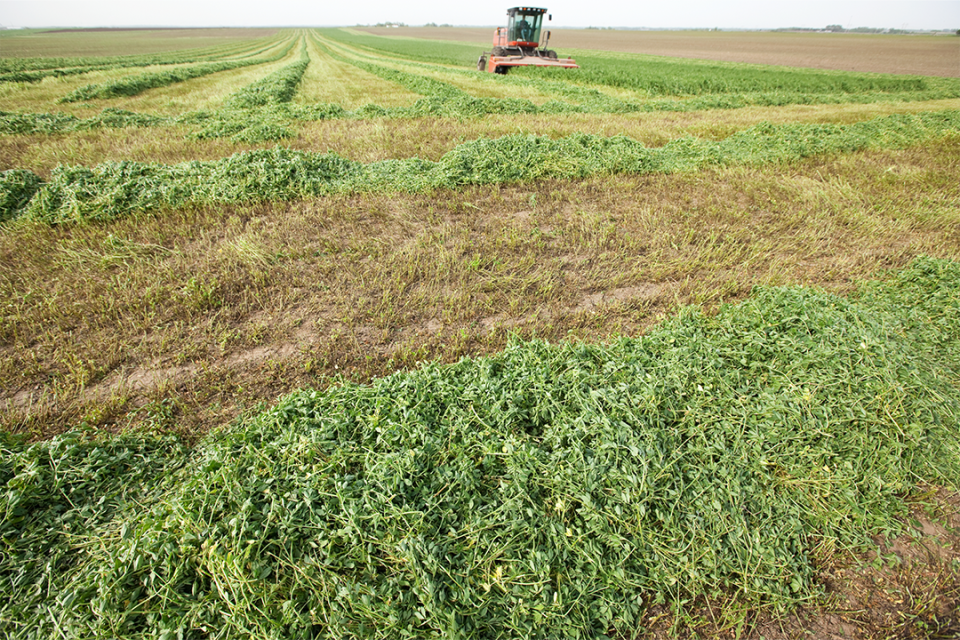
Pasture and Forage Minute: Managing Alfalfa Windows, Grazing Summer Annual Forages and Water Quality
Alfalfa Windrow Management
Timely curing alfalfa windrows can be a challenge with rain and adverse weather. Also, alfalfa stems dry slower than leaves, so higher nutritional value leaves sometimes dry and drop from the stems prior to baling. As the in-field hay drying extends beyond the traditional two to three days, alfalfa regrowth usually becomes yellow under the windrows. Then, progressive strips of light green or chlorotic yellow may develop within alfalfa fields due to lack of sunlight and reduced photosynthesis, leading to weakened, yellow plants that are slow to regrow and potentially more prone to disease.
To overcome alfalfa hay harvesting challenges, research has documented the advantages of wider windrow swaths and crimper conditioning to lower harvest drying times. Compared to taller windrows, wider swaths dry alfalfa 25 to 40% quicker, since wider widths intercept more solar rays. Another consideration for decreasing windrow curing time is allowing the alfalfa to grow longer into mature stages at the time of swathing, since plant moisture content decreases as plants age. So, if the alfalfa stand is already thin or under stress, it is recommended to wait longer for hay cutting. Whereas, if the stand is strong and vigorous, cutting the stressed areas earlier will be fine.
If high quality hay is needed such as for dairies, then the early bud to 10% bloom alfalfa stage is the trigger for cutting. If the targeted harvested hay use is for beef cows or feedlot cattle, then swathing can be delayed to provide more growing time for the stunted plants to increase field biomass before the next cutting.
Adverse weather conditions or rainy days can delay swathing and baling. Consider using wider windrows and possibly delay swathing harvest timing to reduce potential yellowing alfalfa disease.
Faster windrow baling will reduce alfalfa regrowth trampling and potentially make your next cutting plants stronger with increased nutrition and hay value.
Grazing Summer Annual Forages
Summer annual forages such as sudangrass, sorghum-sudan hybrids and pearl millet planted this spring soon could be ready to graze. There are some grazing guidelines to help avoid potential hazards.
The first guideline is to never turn hungry animals into sudangrass or sorghum-type pastures. The reason why is because they may eat so rapidly that they could get a quick overdose of prussic acid and die. All sudangrass and sorghum-type hybrids can produce a compound called prussic acid that is potentially poisonous. Prussic acid, which also is called cyanide, is nothing to fear though, as long as you use a few precautions to avoid problems.
The highest concentration of prussic acid is in new young shoots, so let your grass get a little growth on it before grazing to help dilute out the prussic acid. Let sudangrass get 15 to 18 inches in height before grazing. Sorghum-sudan hybrids usually have a little more prussic acid risk, so wait until they are 18 to 24 inches tall.
Pearl millet does not contain prussic acid, so if you planted millet these grazing precautions aren’t needed. Pearl millet can be grazed when it reaches 12 to 15 inches tall.
Nitrates also can accumulate in these grasses, particularly when there are droughty conditions and/or excess nitrogen fertilization. Avoid grazing these grasses too short, since nitrate concentration is highest in the lower parts of the stems.
Summer annual grasses respond best to a simple, rotational grazing system. Divide fields into three or more smaller paddocks of a size that your animals can graze down to about eight or so inches of leafy stubble within seven to 10 days. Repeat this procedure with all paddocks. If grass in some paddocks gets too tall, it could be cut for hay.
A well-planned start, good rotation and a little rain can give you good pasture from these grasses all the rest of the summer.
Water Quality
When cattle are on pasture, both forage and water quality are important for healthy animals. Surface water is particularly prone to quality issues, such as blue-green algae, salinity, mineral concentrations or nitrate.
Several factors can cause livestock water to be less than ideal for quality, which can impact animal productivity and health. While not common in Nebraska, salinity or minerals can cause animals to limit or refuse consumption in some locations. In some circumstances, concentrations can become high enough to be toxic. Dissolved salt and mineral concentrations increase with dry conditions as water evaporates.
Another issue more common in Nebraska surface water is high nitrates. While elevated nitrates from groundwater sources feeding a pond may be a cause, more common is runoff from other sources of nitrate contamination. Cattle can deal with nitrate levels in water that are unsafe for human consumption, but the real danger comes from elevated nitrate levels in water coupled with feed sources that are also high in nitrates. The compounding effect can push a borderline ration into toxic levels or accelerate nitrate toxicity that is already occurring.
Blue-green algae is a very common occurrence in still water during the summer months. If the conditions are right, a bloom of growth can occur quickly, contaminating the water. Consumption can kill livestock within 24 hours. Algae blooms have traditionally been treated with copper sulfate following proper instructions for rates and exclusions. However, when booms become more frequent, repeated copper treatments can cause a buildup of the element in the environment and animal management becomes our preferred response.
Assuring water is good quality will go a long way toward making summer grazing better and healthier cattle.
Online Master of Science in Agronomy
With a focus on industry applications and research, the online program is designed with maximum flexibility for today's working professionals.
